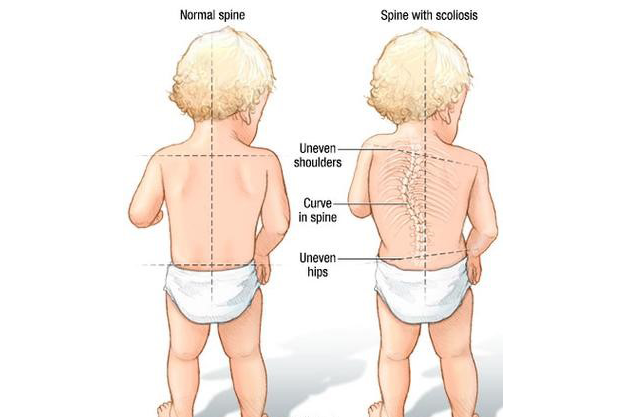
Scoliosis in Kids
Does your kid slightly lean on one side while walking or bending? Are you worried about the slight twist or unusual curve that your kid is having? It might be scoliosis but as long as it is not extreme, do not panic. Your child will be able to enjoy all the activities and perform sports without any complications. Sooner the scoliosis is identified and at a young age, better it can be treated.
What is scoliosis? Does it commonly occur in kids?
Scoliosis is a type of spinal deformity where the spine has a side-by-side or lateral curvature rather than being normally straight when looked from behind. The curvature could be S or C shaped and the person having this appears as if is leaning to one side. Scoliosis in kids is less common. Only 2 to 3 percent of children of school age are reported to have scoliosis. Most common type of scoliosis that affects kids is idiopathic scoliosis.
Why does Scoliosis happen in children? Is it genetic?
The reason or cause for a kid to have scoliosis can vary. The exact cause in 80% of the scoliosis cases are unknown. The possible causes could be the following
- Lack of vertebrae separation
- Partial formation vertebrae
- Absence of vertebrae
- Failure of vertebrae formation
- Muscular dystrophy
- Spine Bifida
- Cerebral palsy
- Spinal cord tumors
- Paralytic conditions
- Neurofibromatosis
- Tumors
- Infection
- Injury
- Difference in the lengths of legs
Kids with progressing scoliosis generally go through hormonal problems, abnormal nerve, muscle, and bone growth during their growth spurt which can be genetic.
Is surgery safe for Scoliosis in kids?
Growing kids with curves of more than 40 degrees are recommended for surgery which involves spinal fusion. In a few cases, surgery can lead to extreme complications such as loss of skin sensation, loss of strength in feet, loss of bladder and bowel control. The neurological complications start to appear within a few weeks of surgery. The side effects can be temporary or permanent. With physiotherapy, the complications can be minimized and often avoided.
What are the symptoms of Scoliosis in kids?

Kids with scoliosis can experience varied symptoms. Some of the common symptoms include
- Uncentred head leading to loss of balance with locomotion,
- Uneven shoulders
- Irregular hip position,
- Height difference with sides of the back when leaning down
- Difference in arm height when standing straight
How to test for scoliosis?
Physical examination along with X-rays is commonly used to diagnose the degree of spinal curvature in kids having idiopathic scoliosis. For other types, MRI AND CT scans may be necessary to gather detailed images of spine along with organs, bones, muscles, fat and other structures surrounding it.
How to treat scoliosis in kids?
The treatment for scoliosis in kids is determined by the doctor after examining the cause, extent of curvature, kid’s tolerance to procedures, therapies, and medications. Repeated examinations are necessary to check if the curve is growing. Progression normally slows down after the kid reaches puberty. If the curve is more than 25% and is still increasing, bracing may be used. In case of curve measuring more than 45 degrees, surgery may be recommended.
Types of scoliosis in children
Depending on the age, a child may be affected with one of three types of scoliosis. Infantile idiopathic scoliosis (between 0 to 3 years of age), Juvenile idiopathic scoliosis (between 4 to 10 years of age), and Adolescent idiopathic scoliosis (between 11 and 18 years of age).
Based on the cause, scoliosis in kids can be congenital, Neuromuscular and syndromic. Congenital Scoliosis is caused when spine develops irregularly in the mother’s womb. Neuromuscular scoliosis occurs when the kid has spinal cord, brain and muscular system disorders. Syndromic scoliosis happens as a result of an existing disorder or syndrome such as muscular dystrophy, and Marfan syndrome.
Essential things a parent should know about scoliosis in kids
Since scoliosis is progressive, parents need to give extra care and attention if they find that their kids have any of the symptoms of scoliosis. Here are some of the key things to consider
- Detection of scoliosis early is essential as scoliosis gets pronounced during preteen and teenage years.
- Regular checkups are essential to know the state of the condition and if treatments given are effective.
For more information, please contact www.rapidphysiocare.com or call +65 6904 4900
Tags : Physiotherapy



